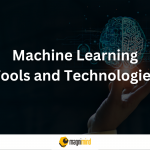The way several industries are governed is about to change as blockchain technology gains popularity. It’s almost a given that the concept of “middlemen” is on its way out, replacing them with decentralized, transparent, and accountable data tracking systems. In this regard, blockchain systems may be a significant advancement for big data analytics, as they lessen the chance of data manipulation. Here we will talk about how blockchain technology may help big data analytics. Initially, we will introduce a summary of blockchain systems and big data, then explore their relationship with each other. Subsequently, we will provide a concise list of the advantages of utilizing blockchain technology for big data.
What is Blockchain Technology?

Blockchain is a secured, shared, immutable ledger that facilitates the process of recording transactions and tracking assets in a business network. Blockchain allows us to store and share information in a secure, decentralized way.
It uses peer-to-peer networks, cryptographic proof of work algorithms, and nodes to create consensus about the state of shared data at any given time. Blockchains can be public or private, and they can store various types of information beyond just transactions between two parties.
How does Big Data work?

The era of Big Data has emerged, generating vast quantities of data every day. For instance, Facebook alone amasses over 300 petabytes of user information, including profiles, images, videos, and messages. This enormous data production has given rise to new domains such as data analytics and big data, which help comprehend human behavior and foster innovation across various sectors, including economics, social, political, and medical fields.
Big data refers to data sets that are characterized by their large size, diversity, and complexity. Three types of big data structures can be defined: structured, unstructured, and semi-structured data.
- Structured data refers to databases that are organized into tables with rows representing individual records (also known as tuples).
- Unstructured data may include free text like articles or blog posts; images such as photographs or videos; audio recordings such as podcasts or interviews; and sensor-generated measurements such as location coordinates, temperature, humidity, and pressure readings.
- Semi-structured data is a mix of structured and unstructured data, meaning it has some organizational structure but does not fit perfectly into a pre-defined format.
Big Data is a valuable resource for the global economy. However, its sheer volume poses challenges for traditional systems in processing and analyzing it. As companies gather data to enhance customer experiences, they encounter significant hurdles like data privacy and security.
Traditional database management systems may struggle to handle big data, but this is not the only challenge posed by these types of data sets. Advanced technologies and techniques such as distributed computing, machine learning, and data mining are often required to effectively analyze big data and extract valuable insights.
The relationship between Blockchain and Big Data

The connection between Blockchain and Big Data benefits both sides. Big data analysis helps businesses use tons of messy data to make smarter choices and enhance their operations. Meanwhile, blockchain tech offers a safe way to store this data without relying on a central authority.
Benefits of Using Blockchain in Big Data Analytics
Blockchain technology could cause a major transformation in data analytics. The use of blockchain for data analysis provides several advantages such as:
Secure data and keep it private
Blockchain technology can enhance the security of sensitive data by enabling tamper-proof storage and efficient data sharing across a network. While blockchain does not inherently provide anonymity, it can enable the controlled sharing of information without the need for a central authority or intermediary. This can be especially useful for scenarios involving confidential information such as medical records or financial transactions, where privacy is a concern.
Make transactions easier
A unique feature of blockchain technology is operating in a decentralized manner. It doesn’t require a central authority such as a bank. All the computer nodes on a network validate any transactions that occur instead of an intermediary being involved. These nodes will have to come to an agreement concerning the condition of the blockchain for a transaction to be considered approved. This process is called “consensus.”
Even though blockchain transactions usually outpace conventional payment systems in speed and efficiency, other elements like network traffic jams can reduce transaction speeds.
Keep your data secure
Blockchain does not possess a shared hub that contains all of its data; instead, the information is dispersed across a range of computers in order to guard against potential infiltrations or data realizations.
Each block in a blockchain has its own unique code which makes it easier to verify whether any changes have been made since the last time it was verified by someone else.
Confidence in external data
Businesses often struggle to validate the authenticity of data sourced externally, which can lead to untrustworthy insights. Blockchain implementation facilitates easy verification of external data, bolstering confidence in the information obtained from external sources.
Permanence and traceability
Blockchain technology ensures data sets are unchangeable and fully traceable, offering data visibility and uniformity to all network participants. This feature enables data auditing, as the entire data trail is accessible on the shared ledger from its origin.
Fraud detection in real-time
Currently, organizations such as financial institutions rely on reactive or retrospective data analytics to identify fraudulent activities. Blockchain technology enables real-time transaction monitoring, allowing for predictive analysis to recognize risky or fraudulent transactions and avert potential issues.
Cost-effective data storage
Traditional cloud storage can be expensive for businesses storing massive data volumes. Blockchain technology provides a more affordable solution for data storage.
Conclusion

As it stands, the use of blockchain in big data analytics is still in its first steps but developing day by day. We can witness it becoming a widely used technology in the near future. In fact, there are already many companies that are exploring this possibility and have even implemented pilot projects to test out their theories.
. . . To learn more about variance and bias, click here and read our another article.










